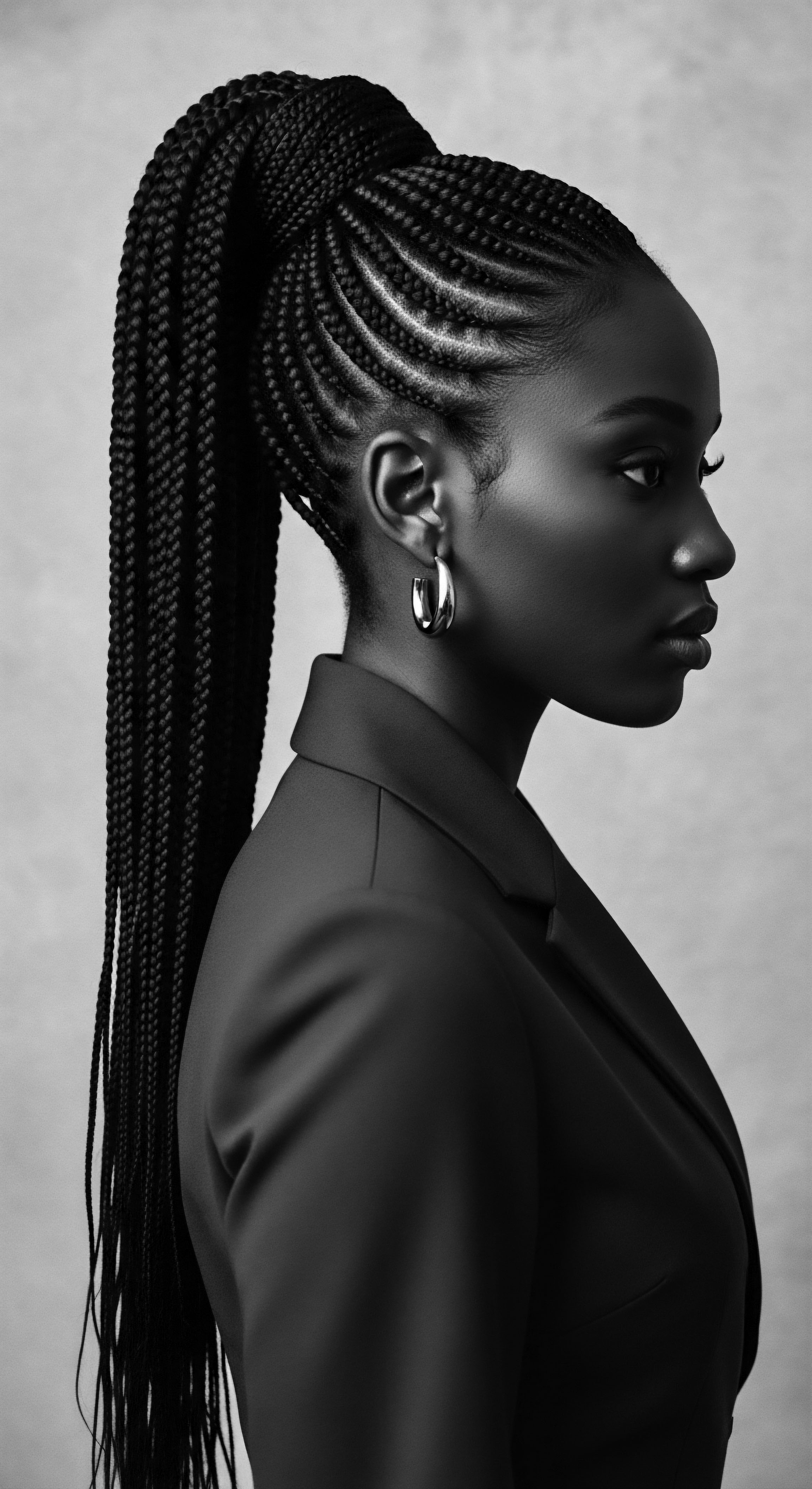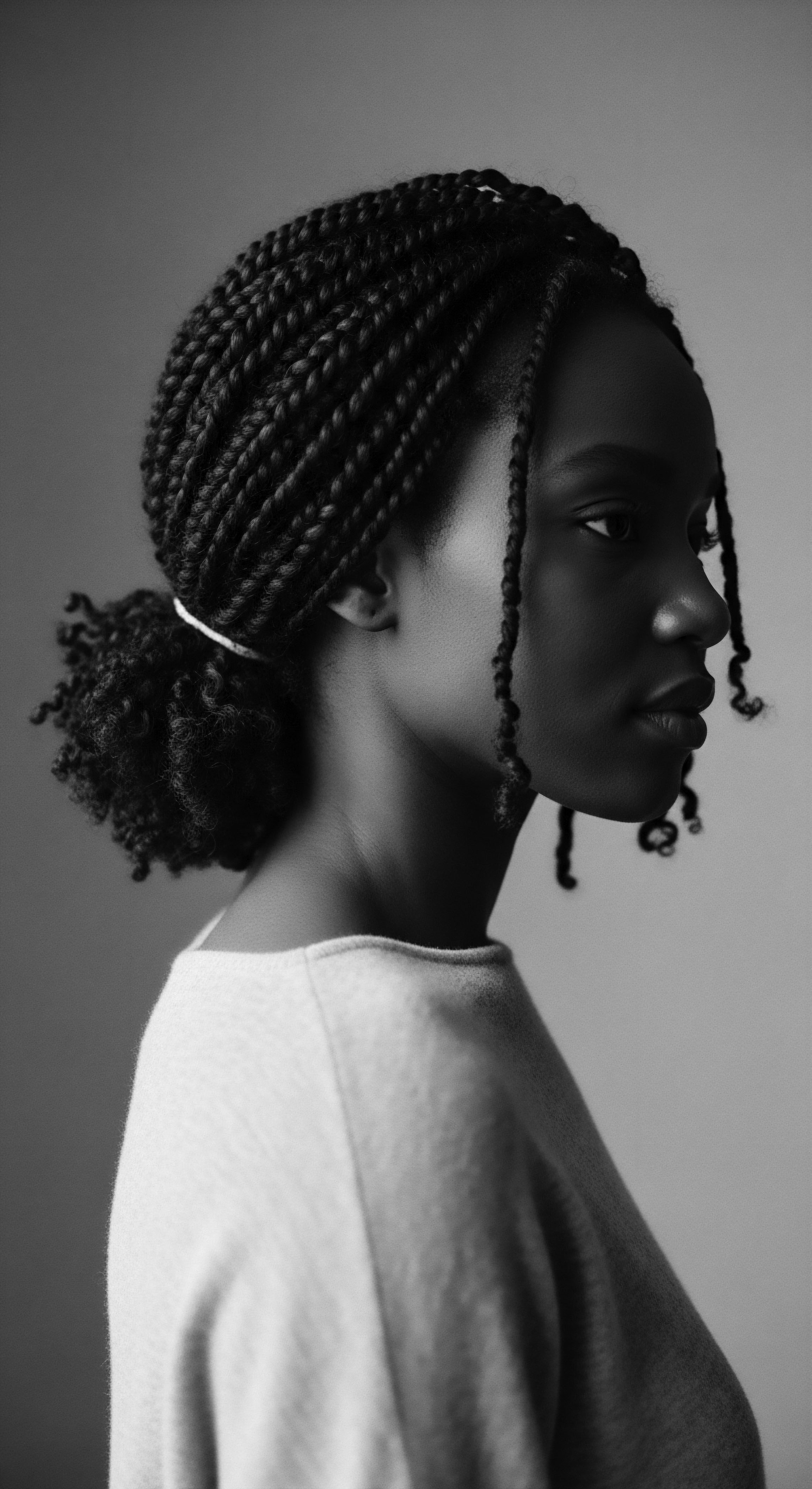
Fundamentals
Reproductive Autonomy, at its foundational level, signifies the inherent capacity of individuals to make decisions about their own bodies and reproductive lives, free from coercion, discrimination, or violence. This basic understanding, while seemingly straightforward, carries a profound weight, particularly when viewed through the historical lens of textured hair heritage. It is not merely about biological functions or clinical choices; rather, it encompasses the deeply personal and often culturally significant choices that shape one’s identity and future.
The term, in its broadest sense, means the freedom to choose, or not to choose, matters related to one’s own reproduction and, by extension, the expression of self. This involves a recognition of individual agency over bodily integrity, a concept that has been historically denied to many, especially those within Black and mixed-race communities.
When we consider this definition through the unique lens of textured hair, the concept of Reproductive Autonomy expands to include the right to determine how one presents their hair, which has historically been a powerful symbol of identity, status, and resistance. The very act of caring for and styling textured hair, particularly in ancestral traditions, has been a demonstration of self-determination, a quiet assertion of dignity in the face of oppressive forces. The choice to wear one’s hair in its natural state, or to adorn it with styles passed down through generations, becomes an act of reclaiming power and heritage.

The Hair as a Canvas of Choice
The scalp, with its vibrant array of textured hair, becomes a canvas upon which Reproductive Autonomy is expressed. For generations, the manipulation, styling, and care of Black and mixed-race hair have been far more than aesthetic pursuits; they have been acts imbued with deep social, cultural, and spiritual meaning. The choice of a particular braid pattern, the decision to wear locs, or the adoption of an Afro, each carries a story, a lineage, and a declaration of selfhood.
These are not merely fashion statements; they are declarations of a right to self-expression that extends to the very strands that grow from one’s head. The concept of Reproductive Autonomy, in this context, is about the freedom to cultivate and present one’s hair in ways that honor personal identity and ancestral connections.
Reproductive Autonomy, when viewed through the lens of textured hair heritage, is the inherent right to self-determination over one’s bodily presentation, especially concerning hair, which has long served as a powerful cultural and personal identifier.
Historically, for Black and mixed-race communities, the ability to make choices about one’s hair was often denied. During periods of enslavement and colonialism, hair was often forcibly shorn or manipulated to erase cultural identity and impose Eurocentric standards of beauty. Yet, even in these dire circumstances, acts of subtle resistance, such as braiding rice seeds into hair to preserve ancestral crops, demonstrated an unwavering spirit of autonomy. This enduring spirit, passed down through generations, continues to shape the understanding of Reproductive Autonomy within these communities today.
- Self-Expression ❉ The freedom to choose hairstyles that align with one’s personal identity and cultural heritage.
- Bodily Integrity ❉ The right to maintain one’s hair in its natural state without pressure or discrimination.
- Cultural Preservation ❉ The ability to continue and adapt ancestral hair practices, passing them to future generations.

Intermediate
Stepping beyond the elemental explanation, Reproductive Autonomy unfolds as a nuanced concept, particularly within the living traditions of textured hair care. It is an acknowledgment that choices regarding one’s hair are intrinsically linked to a broader spectrum of self-determination, encompassing not only personal preference but also collective identity, historical resilience, and the transmission of ancestral wisdom. This intermediate understanding recognizes that for Black and mixed-race individuals, hair is not a passive biological attribute; rather, it is an active medium through which cultural narratives are perpetuated, challenges to oppressive norms are mounted, and personal well-being is cultivated. The significance of this autonomy deepens when we consider the historical efforts to strip away these very choices, transforming hair into a battleground for identity.

The Tender Thread of Ancestral Care
The acts of washing, oiling, detangling, and styling textured hair are not merely chores; they are rituals, often performed with a tenderness passed down through familial lines. These practices embody a deep respect for the hair’s unique structure and its connection to ancestral knowledge. Reproductive Autonomy, in this sphere, is the freedom to choose these traditional methods, to seek out ingredients known to generations past, and to engage in communal hair care practices that strengthen bonds and preserve cultural memory. It is about valuing the inherited wisdom that understands the needs of coily, kinky, and curly strands, recognizing that this knowledge itself is a form of power and self-possession.
Consider the profound meaning embedded in the simple act of braiding. In many African cultures, braids conveyed intricate messages about a person’s age, marital status, social rank, and even spiritual beliefs. During the transatlantic slave trade, cornrows were ingeniously used to hide rice seeds, ensuring the survival of staple crops in new lands, and to map escape routes, acting as silent yet powerful acts of defiance and autonomy. This historical context underscores that Reproductive Autonomy, for those with textured hair, has always been intertwined with acts of resistance and the preservation of heritage, even under the most brutal conditions.
The intermediate understanding of Reproductive Autonomy in textured hair heritage highlights the interwoven nature of personal choice, cultural identity, and historical acts of resistance through hair care practices.
The modern natural hair movement, a resurgence of embracing authentic textured hair, serves as a powerful contemporary manifestation of this autonomy. It is a collective declaration against Eurocentric beauty standards that historically devalued Black hair. This movement has not only reshaped perceptions of beauty but has also catalyzed significant economic shifts, with a surge in Black-owned hair care businesses and a notable increase in sales of natural hair products.
According to a 2019 report by American Express, businesses owned by African American women grew 164% from 2007 to 2019, with much of this growth concentrated in the beauty and personal care sectors, driven by the natural hair movement. This statistic speaks volumes about the economic and social impact of exercising Reproductive Autonomy in hair choices.
The journey of Reproductive Autonomy, from ancestral hearths to contemporary salons, reflects a continuous thread of self-determination. It reminds us that hair care is not merely a cosmetic routine; it is a profound act of self-love, cultural affirmation, and a connection to a rich, enduring heritage.
| Traditional Practice Cornrow Braiding |
| Cultural Significance Encoded messages, social status, tribal affiliation, survival during slavery. |
| Link to Reproductive Autonomy Maintaining identity and agency under oppression, asserting self-determination through coded communication. |
| Traditional Practice Oiling and Scalp Care |
| Cultural Significance Spiritual connection, nourishment, community bonding. |
| Link to Reproductive Autonomy Choosing natural, ancestral methods for holistic well-being and honoring inherited wisdom. |
| Traditional Practice Adornment with Beads/Shells |
| Cultural Significance Symbol of wealth, marital status, artistic expression. |
| Link to Reproductive Autonomy Personal expression and declaration of status within community norms. |
| Traditional Practice These practices underscore how deeply hair care traditions are intertwined with personal and collective autonomy, reflecting a legacy of resilience and self-expression. |

Academic
The academic elucidation of Reproductive Autonomy, particularly through the prism of textured hair heritage, delineates a complex interplay of biological realities, socio-historical forces, and deeply embedded cultural meanings. This is not a simplistic definition; rather, it is an intricate exploration of how individual agency over one’s body, specifically one’s hair, becomes a nexus for power, identity, and liberation within Black and mixed-race experiences. It moves beyond a mere description of choice, delving into the profound significance of that choice within contexts marked by systemic oppression and the enduring legacy of colonialism. Here, Reproductive Autonomy is understood as the unfettered right to self-govern one’s hair, a right that has been historically contested, yet persistently reclaimed as a site of profound personal and communal resistance.

Echoes from the Source ❉ Biology and Ancient Practices
The very structure of textured hair—its varied curl patterns, density, and unique physiological needs—is a biological given, yet its care and presentation have never existed in a vacuum. Ancient African societies, with their deep understanding of the human form and its connection to the spiritual realm, recognized hair as a sacred conduit. The head, being the highest point of the body, was often seen as a direct link to the divine and ancestral wisdom. This reverence translated into intricate hair care practices and elaborate styles that communicated social standing, age, marital status, and tribal identity.
These practices, passed down through generations, were not merely cosmetic; they were integral to the social fabric and individual’s place within the community. The careful tending of hair, often a communal activity, served to reinforce kinship bonds and transmit cultural knowledge. This foundational understanding of hair as a profound marker of self and community sets the stage for appreciating the depth of Reproductive Autonomy within this heritage.
The historical imposition of Eurocentric beauty standards during the transatlantic slave trade and colonial periods represents a stark violation of this inherent Reproductive Autonomy. Enslaved Africans were often forcibly shorn of their hair, an act designed to strip them of their identity, sever their ties to ancestral practices, and dehumanize them. Yet, even in the face of such brutality, resilience shone through. As noted by Carney and Rosomoff (2009), enslaved West African women ingeniously braided rice seeds into their cornrows, a defiant act that ensured the survival of vital food sources in the Americas.
This historical example underscores the deep connection between hair, survival, and the assertion of autonomy even in the most constrained circumstances. This act was not just about physical sustenance; it was a profound declaration of cultural continuity and self-determination, a testament to the enduring power of hair as a repository of heritage.
Reproductive Autonomy, within the context of textured hair, represents the enduring right to self-determination over one’s hair, a right deeply intertwined with historical resistance, cultural preservation, and individual identity.

The Unbound Helix ❉ Voicing Identity and Shaping Futures
The journey of textured hair through history is a compelling illustration of the ongoing struggle for Reproductive Autonomy. The Civil Rights and Black Power movements of the 1960s and 70s saw the Afro emerge as a powerful symbol of defiance and self-acceptance, a visible rejection of imposed beauty norms. This was a direct reclaiming of Reproductive Autonomy, a collective assertion of the right to wear one’s hair in its natural state, unapologetically. This assertion was not without consequence; discrimination based on hair texture and style has persisted in workplaces and schools, leading to legislative efforts like the CROWN Act to protect this fundamental right.
The psychological impact of hair discrimination on Black women is well-documented. Research indicates that Black women’s hairstyles are 2.5 times more likely to be deemed unprofessional by others, leading to feelings of anxiety and self-consciousness. (Dove and LinkedIn, 2023) This systemic bias directly impinges upon Reproductive Autonomy, forcing individuals to choose between professional acceptance and authentic self-expression. The rise of the natural hair movement in recent decades represents a renewed and powerful wave of exercising this autonomy.
It is a global phenomenon, driven by a desire for self-love, cultural pride, and holistic well-being. This movement has not only transformed perceptions of beauty but has also stimulated significant economic growth, with the global natural hair care products market projected to reach USD 16.01 billion by 2029. This economic shift underscores the tangible impact of collective Reproductive Autonomy on market forces and cultural industries.
The academic discourse on Reproductive Autonomy in this context also examines the concept of “hair politics,” recognizing that choices about hair are deeply political, reflecting broader societal power dynamics. The decision to wear natural hair, for many, is a conscious act of decolonization, challenging the lingering effects of colonial mindsets that privileged European features. It is an assertion of self-worth and a reaffirmation of a rich cultural heritage that has been historically marginalized. This continuous negotiation between personal choice and societal expectation highlights the dynamic and ongoing nature of Reproductive Autonomy, particularly for those whose hair carries such profound historical and cultural weight.
- The Afro ❉ A powerful symbol of Black pride and resistance during the Civil Rights and Black Power movements, challenging Eurocentric beauty standards.
- Locs ❉ Historically significant and spiritually revered, locs represent a commitment to natural growth and a connection to ancestral traditions.
- Braids ❉ Beyond their aesthetic appeal, braids have served as intricate communication systems and a means of preserving cultural identity.
The academic lens reveals that Reproductive Autonomy, in its most comprehensive interpretation, is a continuous act of self-creation and cultural affirmation, a testament to the enduring spirit of those who refuse to let their heritage be erased.

Reflection on the Heritage of Reproductive Autonomy
As we close this exploration, the profound truth of Reproductive Autonomy, as experienced through the lineage of textured hair, settles upon the spirit like a gentle balm. It is a concept not confined to legal statutes or medical clinics, but one that breathes with the very rhythm of ancestral memory, finding its voice in every curl, coil, and wave. The journey from the elemental biology of hair to the intricate patterns of ancient practices, and then to the bold assertions of identity in our present day, reveals a continuous, unbroken thread of self-possession.
The Soul of a Strand ethos reminds us that each hair follicle carries a story, a whisper of generations past who nurtured, adorned, and even coded messages within their hair as acts of quiet rebellion. The ability to choose one’s hairstyle, to embrace the hair that grows from one’s scalp without fear or prejudice, is a fundamental human right that has been hard-won and continues to be defended. It is a testament to the resilience of Black and mixed-race communities, whose hair has consistently been a visible declaration of their enduring spirit, a living archive of their heritage.
In the tender act of caring for textured hair, whether through time-honored rituals or contemporary practices that honor traditional wisdom, we participate in this ongoing narrative of autonomy. We acknowledge that the choices we make about our hair are not trivial; they are deeply personal affirmations of who we are, where we come from, and the futures we envision. This continuous dialogue between past and present, between ancestral knowledge and modern understanding, ensures that Reproductive Autonomy, in the realm of textured hair, remains a vibrant, evolving testament to the power of self-determination.

References
- Afriklens. (2024). African Hairstyles ❉ Cultural Significance and Legacy .
- American Express. (2019). The 2019 State of Women-Owned Businesses Report .
- Byrd, A. D. & Tharps, L. L. (2002). Hair Story ❉ Untangling the Roots of Black Hair in America. St. Martin’s Press.
- Carney, J. A. & Rosomoff, R. N. (2009). In the Shadow of Slavery ❉ Africa’s Botanical Legacy in the Atlantic World. University of California Press.
- Cultural Survival. (2020). Honoring the Spiritual Legacy, Resiliency, & Healing Power of Our Ancestors Through Indigenous Customary Hair Traditions .
- Dove and LinkedIn. (2023). CROWN 2023 Workplace Research Study .
- Mintel. (2015). Natural hair movement drives sales of styling products in US black haircare market .
- Mintel. (2018). Black haircare market value report .
- Opie, T. & Phillips, K. (2015). African American Women’s Perceptions of Self-Value in the Transition to Natural Hair. Walden University Research.
- ResearchGate. (2023). Entrenched Coloniality? Colonial-Born Black Women, Hair and Identity in Post-Apartheid South Africa .
